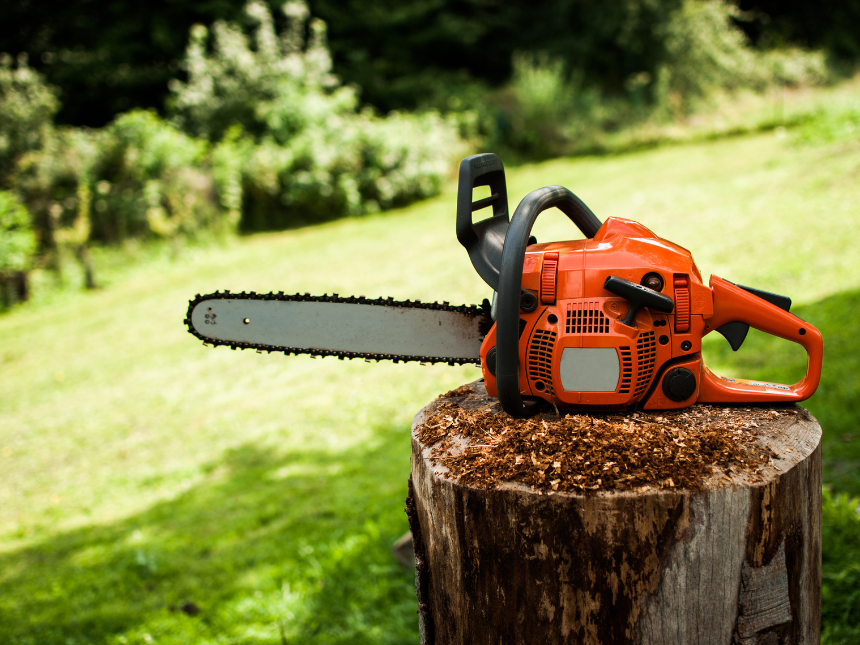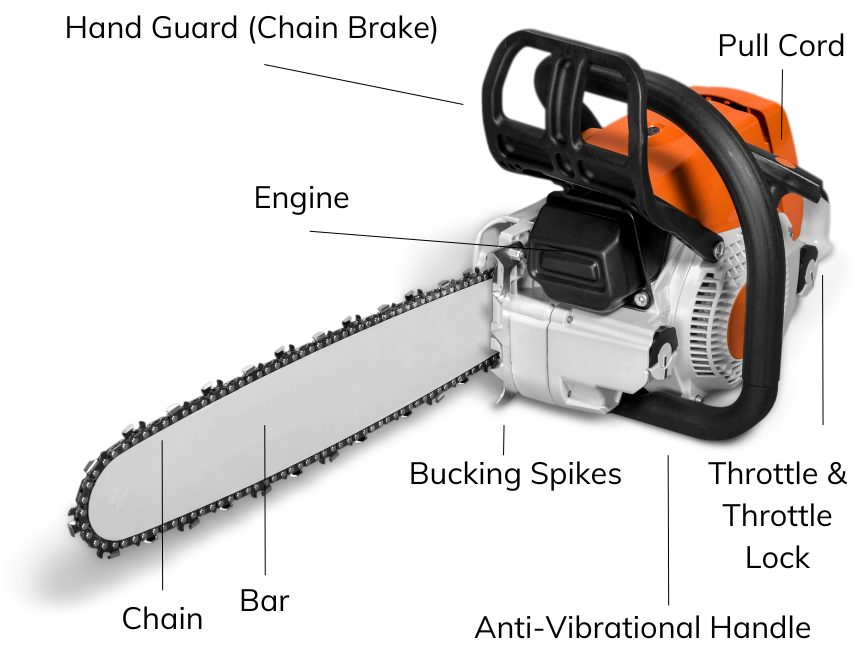Parts Of A Chainsaw: The Most Important Things To Know

The parts of a chainsaw will vary by type and model. Electric-powered chainsaws will not have the same parts as a gas-powered chainsaw. A chainsaw from Stihl will be built differently than one from Echo. Of course, there are some common parts between most chainsaws. And we cover them all below.
Table of Contents
- Top Parts of a Chainsaw
- Anti-Vibration Handle
- Hand Guard
- Chain Brake
- Muffler
- Chain Catcher
- Throttle and Throttle Interlock
- Chainsaw Blade (Bar and Chain)
- Chain Sprocket
- Chain Tensioner
- Bumper Spikes
- Spark Arrestor
- Fuel Tank or Battery
- Lubricant Tank
- Pull Cord
- Air Filter
- Spark Plug
- High/Low Adjustment
- Lean Adjustment
- Choke
- Shutter
- Engine
- Decompression Valve
- Manual Fuel Pump (or Primer Bulb)
- Final Say On The Parts of a Chainsaw
- FAQs
The Parts Of A Chainsaw

While this list of tree cutter tools may be long, it's important to remember that you do not need all these tools. Purchase handy tools, like pruners and shears, if you only need to maintain your garden.
Anti-Vibration Handle
The anti-vibration handle is the iconic handle on top of the chainsaw. This is the handle closest to the blade you typically grab off-hand. It has a comfortable grip because all of the weight of the chainsaw will be on this handle, which can cause a lot of stress and fatigue to the hand holding it.
Hand Guard
The hand guard is a safety feature in front of the anti-vibration handle (or top handle). This hand guard prevents your hand from falling forward and hitting the blade, and it also prevents the blade from kicking back and hitting your hand. The chain brake is activated if the blade kicks back hard enough to disengage the hand guard.
Chain Brake
The chain brake is another safety feature located on the inside of the chainsaw in the clutch. When the hand guard is pushed back, the chain brake (a ring inside the chainsaw) activates by grabbing the clutch and sprocket to disengage the blade. It's there as a safety measure to stop the chainsaw from working.
Note: The chain brake and hand guard are often used interchangeably. Most people actually call the handguard the chain brake, and that is because to activate the chain brake, you must engage the hand guard.
Muffler
The purpose of the chainsaw muffler, like any muffler, is to reduce noise. Constant exposure to loud noises, like the ones made by the chainsaw, can damage your hearing over the long term.
Chain Catcher
The purpose of the chain catcher is exactly that: to catch the chain. Let's say the blade breaks and flies off the chainsaw. The chain could wrap around and hit you or your hand in the process.
The purpose of the chain catcher is to prevent this from happening to keep you safe. It catches the chain. You can see why a chain catcher is on the OSHA required parts list.
Did You Know? According to the CDC, approximately 36,000 chainsaw incidents occur each year. Make sure you follow the appropriate safety protocols and use the right PPE when using a chainsaw.
Throttle Trigger and Throttle Interlock
These two parts are used together to operate a chainsaw. In order to use the throttle, you have to have your hand on the throttle interlock. Simply hold on to the throttle interlock and then press the throttle. The throttle gives gas to the engine of the chainsaw, which allows the chainsaw to run.
Chainsaw Blade (Bar and Chain)
The chainsaw blade is what most people think of when they think of the metal portion at the front of the chainsaw that cuts the trees. It's actually the combination of two parts: the bar and the chain.
Bar
The chainsaw bar is the piece of flat metal in the front of the chainsaw that holds the chain.
Chain
The chainsaw chain is what wraps around the chainsaw bar at the front of the chainsaw. Not all chainsaw chains are built the same so you can expect them to be different from model to model. Replacing a chainsaw chain can be somewhat difficult so proceed with caution.
Chain Sprocket
The sprocket is the piece inside the chainsaw attached to the clutch. This drives the chainsaw chain around the bar continuously to cut wood.
Chain Tensioner
The chain tensioner is the piece of the chainsaw you use to tighten the chainsaw chain on the bar. If it's too tight, the chain won't turn fast enough. If it's too loose, the chain can fall off the bar. Most chainsaws today have automatic chain tensioners but it helps to know what they are for older models.
Bumper Spikes
The bumper spikes, also known as bucking spikes, sit at the front of the chainsaw near the bottom, just below the blade. These are great because you can log them into a log or piece of wood and to take the weight off your arms and put it directly onto what you are cutting. It will pull the chainsaw into and through the wood and prevent all that unwanted jerking around when you are cutting the wood.
Spark Arrestor
The spark arrestor is located on the chainsaw behind the blade. It's function is to catch any sparks, or debris, that fling off when you are cutting down trees. This is to prevent fire hazards like sparks from flaring off and causing fires.
Fuel Tank or Battery
This one is pretty obvious, but the fuel tank is where you put the gas into the chainsaw. This typically sits at the back of the device. You can't miss it. You'll unscrew the cap and pour in gas to get the machine going. Not to be confused with the lubricant tank.
If you have an electric motor, you will have a battery as your fuel source. Instead of giving the engine gas, you'll plug it into a wall. And vice versa, an electric powered chainsaw will not have a fuel tank.
Lubricant Tank
On the other side of the chainsaw, you'll have the lubricant tank Lubricant is used to reduce any friction on the chain and bar to prevent it from seizing up.
Pull Cord (or Pull Start)
The pull cord is how you start the chainsaw. It's going to be connected to the flywheel of the engine and beyond that you don't really need to know much more other than this is the cord you pull to get the engine started.
Air Filter
Most gas chainsaws will have a big round air filter attached to the engine. It contributes to both the air and the fuel mixture. It, obviously, filters air going into the engine to prevent unwanted debris from getting in there. You will have to replace the air filter over time. Just part of the game.
Spark Plug
The spark plug is what ignites the fuel in the engine. Obviously, its a combustible engine so you need to ignite the fuel source to get the machine to work. The spark plug provides the heat to the fuel source, allowing it to combust.
High/Low Adjustment
The high-low adjustment screws adjust the chainsaw's maximum and minimum RPM (rotations per minute). This helps you to control the idling speed of the chainsaw. If you want to adjust the high-low of the chainsaw, you'll need to refer to the user manual.
Lean Adjustment Screw
The lean controls the air-in-fuel mixture. It controls the input of the fuel into the carburetor. If you want to adjust the lean adjustment screws of your chainsaw, then you'll need to refer to the user manual.
Choke
The choke is essentially the on/off switch of the chainsaw. You'll engage the choke every time you turn on the chainsaw. You need it to start the chainsaw.
Shutter
The shutter is a small piece of plastic that regulates the chainsaw's temperature for different seasons. It's commonly referred to as the summer-winter shutter. It controls how the chainsaw pulls in air from the environment.
In the summer, you want the chainsaw to pull in air from the environment because it will cool down the blade. In the winter, you want the chainsaw to pull in air from the chainsaw to warm up the chainsaw's components.
Refer to the user manual for more information on installing the shutter. This varies heavily depending on the chainsaw.
Engine
Probably don't need to explain this one too much. This will vary from chainsaw depending on the type and size of chainsaw you purchased and whether or not you went with gas or electric.
Gas-powered chainsaws are going to have a combustion engine that will use gas and air to move the chainsaw blade. Electric motors use electricity to generate this same movement.
Decompression Valve
Larger model chainsaws will have what is known as a decompression valve. It's typically a button on top of the chainsaw and its purpose is to release any pressure inside the piston of the chainsaw. This is one of those parts of a chainsaw that will not be on every model.
Manual Fuel Pump (or Primer Bulb)
The manual fuel pump is that bubble on the side of most gas-powered equipment. You see these on gas leaf blowers, gas-powered weed wackers, etc.
It's just a way for you to manually feed the engine with gas to give it an easier way to get into the engine. Most times, starting a piece of equipment will require you to prime the engine with the manual fuel pump before starting it.
Sweet New Earth Final Say On Parts of a Chainsaw
Like we said already, when it comes to the parts of a chainsaw, there are going to be some differences by type and model of chainsaw. Don't be surprised when you buy a gas-powered chainsaw that it doesn't plug into an outlet for power... you'd be surprised but some people don't understand the difference!
When it comes to repair and maintenance of the chainsaw, be sure to refer to the individual user manual for that specific chainsaw. There shouldn't be too much maintenance required with higher-end models but you never know.
When it comes to power tools, we love gas. So a gas chainsaw would be are our favorite, however electric chainsaws are great for people just starting out with the tool. A gas chainsaw packs more of a punch when it comes to cutting through trees.
FAQs
Before you go...
Now that you know about the individual parts of a chainsaw, you are ready to learn what makes the best chainsaws. They are one of the best tree-trimming tools, so read our extensive guide on the best chainsaws to be prepared when buying your first...
Related Articles:

Carl Anderson
Carl Anderson is an avid outdoorsman with a keen interest in writing about and reviewing tools. He has over 20 years of writing experience and the only time he isn't feverishly typing away at his computer is when he's outside in nature working on his projects. You can learn more about him here.
Join our community!
Join to receive guides, insights, and the latest gardening deals!
